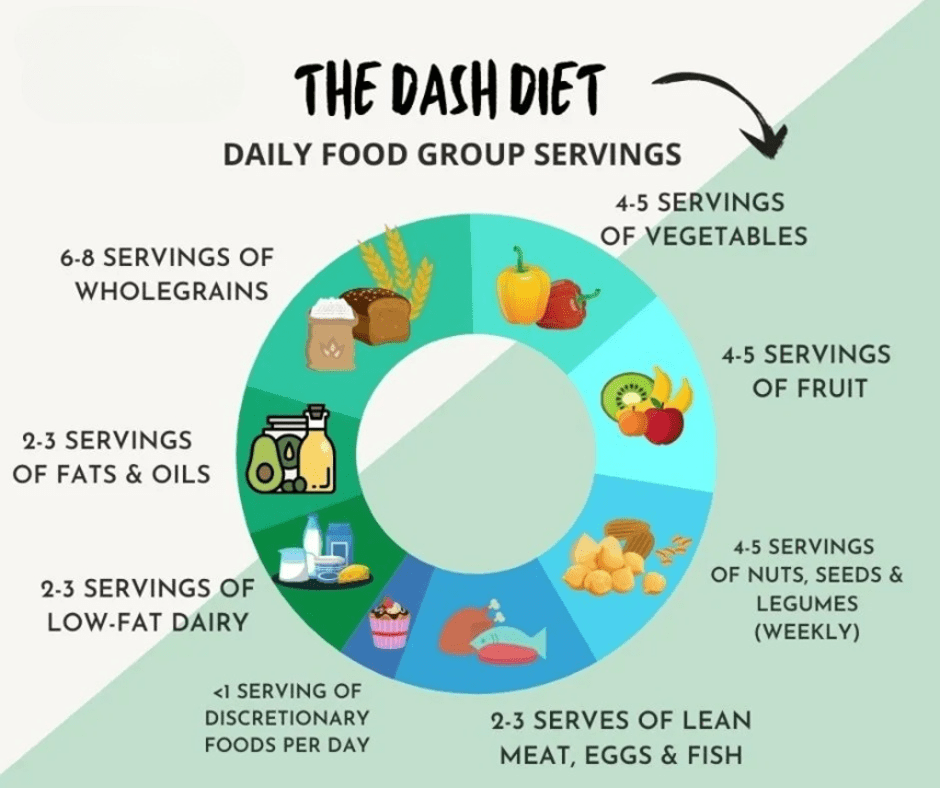DASH stands for “Dietary Approaches to Stop Hypertension”. The National Institutes of Health developed the DASH Diet.
The DASH diet is an eating plan designed to reduce high blood pressure, lower cholesterol levels, and help people maintain a healthy weight.
I will explain the science behind the DASH diet, its various benefits, meal plans, and common questions about it. Read on!
- Science behind the DASH diet
- The DASH diet is not only designed to reduce blood pressure but also to help reduce the risk and the development of other chronic diseases.
- Studies have shown that following the DASH diet can lower LDL (bad) cholesterol levels and reduce the risk of type 2 diabetes, heart disease, strokes, pre-hypertension, metabolic syndrome, and obesity.
- The nutrient-rich diet focuses on the consumption of healthy fats, lean proteins, whole grains, fruits, and vegetables, all of which help promote heart health.
- Outline of the benefits of the DASH diet
- The DASH diet has numerous benefits that can help improve wellness.
- The diet is rich in fruits, vegetables, whole grains, and low-fat dairy products, which are all heart-healthy foods.
- It also limits foods high in saturated fat, which can help reduce the risk of heart disease.
- The DASH diet is also low in sodium, which helps keep blood pressure levels down.
- Meal plans for following the DASH diet
- Meal plans for following the DASH diet should focus on controlling sodium, fat, and cholesterol consumption.
- Eating nutrient-rich foods that are lower in saturated fats, trans fats, and cholesterol, such as lean proteins, whole grains, fruits, and vegetables, is an important part of following the DASH diet.
- Ensuring that all meals are well-balanced to meet nutritional needs is important.
- Sample meal plans might include breakfast options such as oatmeal and low-fat yogurt, snacks like nuts and fruit, and a dinner meal of chicken and brown rice with steamed vegetables.
- Research studies that support the efficacy of the DASH diet
- Studies have shown that following the DASH diet improves blood pressure.
- These studies have demonstrated a decrease in systolic and diastolic blood pressure among people who follow the DASH diet.
- Following the DASH diet has been associated with a lower risk of cardiovascular events, and its effects can be seen in as little as two weeks.
- A growing body of evidence suggests that the DASH diet may have benefits for metabolic health.
- Studies have found that following the DASH diet can improve inflammation, endothelial function, and metabolic parameters, including cholesterol, triglycerides, and fasting glucose levels.

Let’s dive into the DASH diet!
What is the DASH diet?
The DASH diet is a healthy eating plan developed to lower high blood pressure, lower cholesterol levels, and help people maintain a healthy weight.
It emphasizes foods low in salt and fat while encouraging the consumption of fruits, vegetables, and whole grains.
Unlike other diets focused on weight loss, the DASH diet focuses on improving overall health by reducing high blood pressure.
Research has shown that following the DASH diet can significantly lower blood pressure within two weeks.
The diet includes plenty of fruits and vegetables, lean proteins such as poultry and fish, low-fat dairy products such as yogurt and cheese, nuts, legumes, whole grains such as oatmeal and brown rice, as well as some red meat.
On top of these food groups, it recommends limiting sodium intake to no more than 2,300 milligrams per day.
Research suggests that following the DASH diet may also reduce your risk of:
- Stroke
- Heart failure
- Kidney stones and diseases
- Type 2 diabetes
- Certain types of cancer
- Osteoporosis
- Gout
- Depression, anxiety disorders
- Age-related vision loss
- Tooth decay
- Obesity-related illnesses
- Hypertension (high blood pressure)
- Coronary artery disease (CAD)
- Metabolic syndrome or pre-diabetes (insulin resistance)
If you’re looking for an effective way to improve your overall health and well-being without focusing solely on weight loss goals, then the DASH diet is definitely worth considering.
It pushes on fresh produce and whole grains while limiting processed foods full of added sugar or unhealthy fats – it could be just what you need for better health outcomes today!
Benefits of the DASH diet
The DASH diet is an evidence-based diet plan designed to help people improve their health.
It is based on whole grains, fruits, vegetables, lean proteins, and healthy fats – all of which are essential for overall wellness.
It’s been found that following the DASH diet can significantly lower systolic and diastolic blood pressure in those at risk for hypertension or already suffering from it – thanks to its focus on limiting sodium intake and increasing potassium through consuming plenty of fruits and vegetables.
It has been demonstrated to reduce LDL (“bad”) cholesterol while elevating HDL (“good”) cholesterol levels, which can lower the risk of coronary artery disease by minimizing plaque build-up in the arteries.
The balanced nature of this meal plan also aids those looking to maintain a healthy weight or lose some extra pounds since it limits saturated fat consumption whilst encouraging physical activity.
The DASH Diet provides many advantages when followed correctly – particularly when combined with regular exercise!
By making healthier food choices according to this nutritious eating plan and regular physical activity, you can improve your overall well-being while relishing fulfilling meals!
The science behind the DASH diet
The DASH diet is a carefully developed dietary plan which has been tested and proven to help reduce high blood pressure.
Its efficacy lies in its combination of reducing salt intake and increasing potassium consumption. This approach helps maintain normal levels of water balance and electrolyte levels, decreasing blood pressure.
IAdding to reducing sodium, the DASH diet also promotes an increase in fiber-rich foods like fruits, vegetables, whole grains, and legumes, known for their cholesterol-lowering properties.
This helps reduce the risk of heart disease by binding with dietary fat and cholesterol before it can enter the bloodstream.
Lean proteins such as fish, poultry, eggs, and legumes help build muscle mass while keeping calorie intake low; healthy fats like olive oil or avocado can also contribute to feeling full between meals, thus promoting weight loss efforts.
The best of the DASH diet is that it is highly individualized – meaning that with help from a qualified nutritionist or registered dietitian, one’s specific health needs can be addressed without sacrificing taste or satisfaction while gaining numerous health benefits such as improved cardiovascular health and better blood pressure control.

DASH diet meal plan
The DASH diet meal plan is an effective and nutritious way to improve overall health and well-being.
This diet focuses on whole grains, fruits, vegetables, lean proteins, and healthy fats. Depending on your age, sex, and activity level, the recommended daily caloric intake for the DASH diet varies.
A typical day on the DASH diet consists of 4-5 servings of vegetables, 4-5 servings of fruits, 2-3 servings of low-fat dairy, 2-3 servings of lean protein, and 6-8 servings of grains.
When planning meals for the week ahead, it is important to include a variety of foods from each food group to ensure you are getting all the necessary vitamins and minerals.
For breakfast, you could try oatmeal with banana slices or eggs with toast; for lunch, a salad with grilled chicken or Greek yogurt with berries; for dinner, stir fry with brown rice or salmon with sweet potatoes; lastly, snacks could include hummus dip with fresh veggies or an apple slices topped with peanut butter.
Adding healthy fat sources like olive oil or avocado can help control hunger throughout the day.
Meal planning may seem daunting when you start, but it can be made simpler by batch-cooking meals ahead of time, such as soups which can easily be frozen until needed.
Meal prepping is another great way to save time during the week by slicing up ingredients like carrots, broccoli, and peppers which can then be added to salads or stir-fries throughout the week as desired.
Another tip for saving time during meal preparation is choosing recipes that use similar ingredients so that any leftovers can be used again in another dish later in the week.
It is important to remember that when following any dietary plan, it is best to consult a registered dietitian or nutritionist who can provide tailored advice based on individual needs as well as answer any questions you may have about nutritional requirements while following this diet plan.

Common questions about the DASH diet
Before starting the plan, common questions about the DASH diet are important.
- What are the potential benefits of following the DASH diet?
Following this balanced diet can not only help lower high blood pressure, but it can also improve bone strength, and reduce the risk of cancer, and metabolic disorders such as cardiovascular disease and diabetes.
By choosing the right foods and eating a range of foods that offer plenty of nutritional value and are rich in potassium, calcium, and magnesium, the DASH diet can improve overall health while still allowing for complete nutrition.
In just two weeks of following the DASH diet, blood pressure can often drop a few points and if persisted in, can result in significant reductions.
There is a low-sodium version of the DASH diet available, which further reduces sodium consumption to 1500 mg a day.
The DASH diet is a sustainable and wholesome approach to healthy eating and the long-term establishment of healthy eating habits.
From my favorite dietician.
- What foods should be avoided? Are there any associated health risks?
- How much sodium should be consumed on the DASH diet?
- Is it possible to drink alcohol while following this plan?
The potential benefits of following a DASH diet include lowered blood pressure, cholesterol levels, and stroke and heart disease risk.
It may also help with weight management, reduce inflammation, decrease type 2 diabetes risk, improve bone health, strengthen cognitive functioning, aid digestion, regulate hormones related to appetite control, boost energy levels, and improve moods.
It is recommended that those trying out the DASH diet consult a registered dietitian or nutritionist for tailored advice and answers to any questions.
Foods high in sodium, such as processed meats (hot dogs and bacon), canned soups or vegetables (even “low-sodium” varieties), pickles, and olives, should be avoided.
Sugar-sweetened beverages such as soda or juice should also be avoided due to their high sugar content.
Reducing the intake of red meat can also make a difference since many cuts contain high amounts of saturated fat, which can negatively affect cholesterol levels.
Replacing these foods with healthier options like fresh fruits, vegetables, and whole grains can help reduce unhealthy cravings while still providing the necessary nutrients for good health.
It is important to note that consuming too little salt may lead to an electrolyte imbalance in some individuals, which could result in dizziness or dehydration; it is essential that adequate consumption of potassium-rich foods such as bananas or potatoes is maintained while reducing sodium intake on the DASH diet.
Alcohol consumption should also be kept within moderate limits since drinking too much alcohol can cause dehydration, leading to higher blood pressure levels.
Understanding what foods need to be included or excluded from your meal plan when following a healthy eating plan like the DASH Diet provides you with an easy way to reach your health goals without sacrificing taste or quality meals!
With its focus on whole grains, fruits, vegetables, lean proteins, and low-fat dairy products combined with limiting processed meats, sugars sweetened beverages, and red meat, you can make healthy choices that support your overall well-being!


Leave a Reply